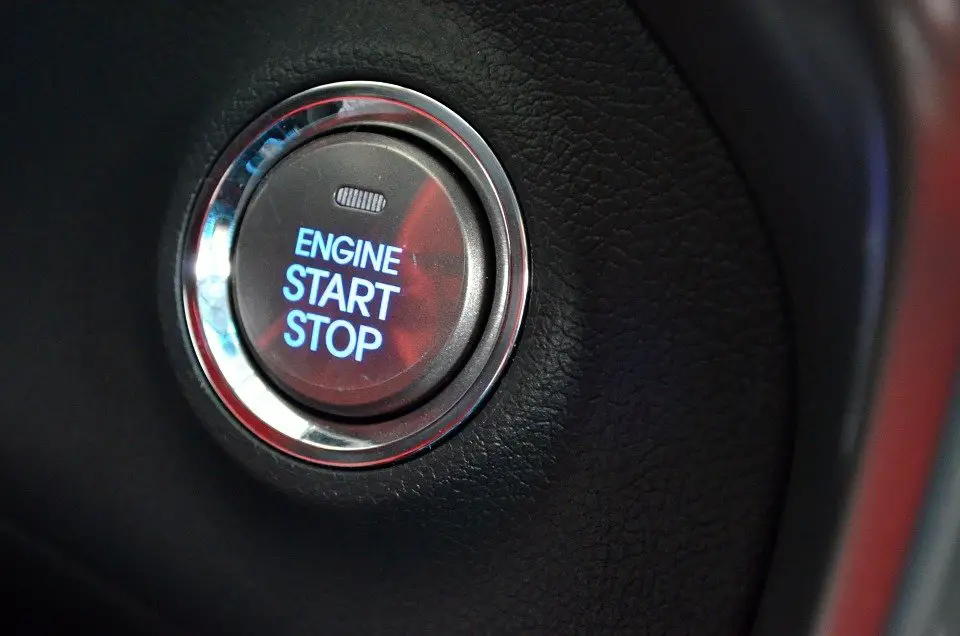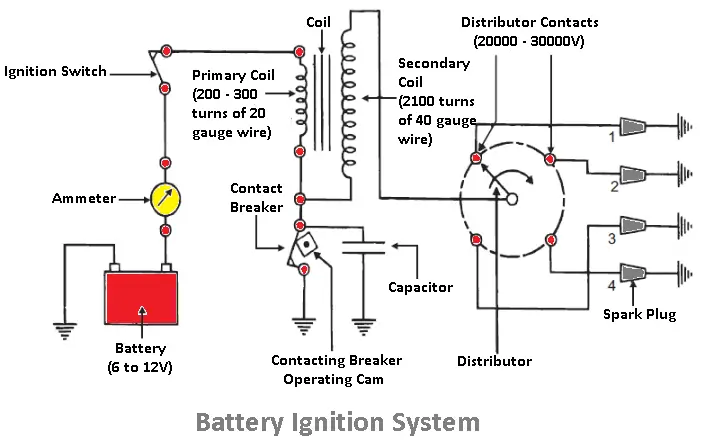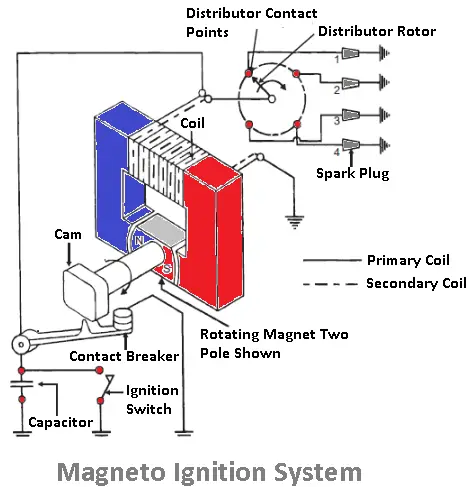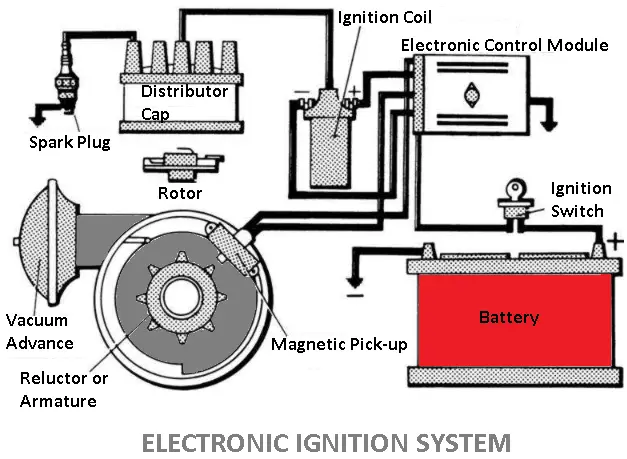In this article, you’ll learn what is ignition system and how it works. Types of ignition system, working, diagrams, and more.
You can download the free PDF file of this article at the end.
What is an Ignition System?
The ignition system is one of the most important systems used in the I.C. engines. The spark-ignition engine requires some device to ignite the compressed air-fuel mixture. The ignition takes place inside the cylinder at the end of the compression stroke, the ignition system serves this purpose.
It is a part of the electrical system which carries the electrical current to a current plug. It gives the spark to ignite the air-fuel mixture at the correct time.

Read our full article on I.C. engines it is one of our best articles. You’ll get all the information about four-stroke and two-stroke engines.
Now back to the ignition system.
Ignition System Parts
The following are the main parts of the ignition system:
- Battery,
- Switch ignition distributor
- Ignition coil
- Spark plugs and
- Necessary wiring.
Some system uses transistors to reduce the load on the distributor contact points. Other systems use a combination of transistors and magnetic pickup in the distributor.
A compression ignition engine does not have such an ignition system. In a compression ignition engine, only air is compressed in the cylinder. At the end of the compression stroke, the fuel is injected which catches fire due to the high temperature and pressure of the compressed air.
An Ignition in The Vehicle
The ignition system supplied high voltage surges of current (as high as 30,000 volts) to the spark plug. These surges produce electric sparks at the spark plug gap. Spark ignites to set fire to the compressed air-fuel mixture in the combustion chamber.
The sparking must take place at the correct time at the end of the compression stroke in every cycle of operation. At high speed or during part throttle operation, the spark is advanced. So that it occurs somewhat earlier in the cycle, the mixture thus has time to burn and deliver its power.
The ignition system should function efficiently at the high and low speeds of the engine. It should be simple to maintain, light, and compact. It should not cause any interference.
Types of Ignition System
The following are the types of ignition systems:
- Battery ignition system or coil ignition system
- Magneto ignition system.
- Electronic Ignition System.
Battery Ignition System

The figure shows the battery ignition system for a 4-cylinder engine. A battery of 12 volts is generally employed. There are two basic circuits in the system primary and secondary circuits.
The first circuit has the battery, primary winding of the ignition coil, condenser, and contact breaker from the primary circuit. Whereas the secondary winding of the ignition coil, distributor, and spark plugs forms the secondary circuits.
The value of the voltage depends upon the number of turns in each coil. The high voltage, 10,000 to 20,000 volts, then passes to a distributor.
It consists of the cylinder’s spark plug in rotation depending upon the engine’s firing order. This causes a high-intensity spark to jump across the gap. Thereby ignition of the air-fuel mixture takes place in all the cylinders.
The battery ignition system has massive use in cars, light trucks, buses, etc.
Magneto Ignition System

The magneto ignition system has the same principle of working as that of the battery ignition system. In this, no battery is required, as the magneto acts as its generator.
It consists of either rotating magnets in fixed coils or rotating coils in fixed magnets. The current produced by the magneto flows to the induction coil, which works like that of the battery ignition system.
This high voltage current is then made to flow to the distributor, which connects the sparking plugs in rotation depending upon the engine’s firing order.
This type of ignition system is used in small spark-ignition engines, for example, Scooters, Motorcycles, and small motorboat engines.
Electronic Ignition System

The conventional electro-mechanical ignition system uses mechanical contact breakers. Though it is very simple, it suffers from certain limitations as follows.
- The contact breaker points handle the heavy current. This results in burnout of contact points. Thus it requires periodical servicing and settings.
- The mechanically operated contact breaker has inertial effects. Hence at higher speeds, the make or break of contact may not be timed.
- At higher speeds, the dwell time for building up the current in the coil to its maximum value is low. Thus the spark strength may be reduced.
To overcome the above drawbacks, in modern automobiles, electronic ignition systems are used. This electronic ignition system performs best at all varying conditions and speeds, unlike electro-mechanical systems.
The electro-ignition system consists of transistors, capacitors, diodes, and resistors. These act as heavy-duty switches in controlling the primary current for the high-voltage ignition coil.
Conclusion
So now, we hope that we have cleared all your doubts about the Working of the Ignition System. If you still have doubts about the “Types of Ignition System” you can contact us or ask in the comments.
That’s it, thanks for reading. If you like our article, then please share it with your friends. You can ask in the comment section if you have any questions about any topic.
Subscribe to our newsletter to get notified when we upload new posts.
Download PDF of this article:
You may be interested in reading these articles:
Thanks for introducing this web site, lam well having a unswerable problems
You’re welcome
Thanks for this education, massage through good explanation you are correctly actual, my question how fuel mixture air and fuel in combustion chamber
Hi, Michael
In our blog, we have all sort of article on the combustion chamber and IC engines please check it out. thanks:)